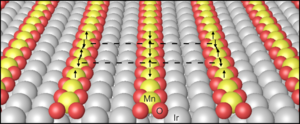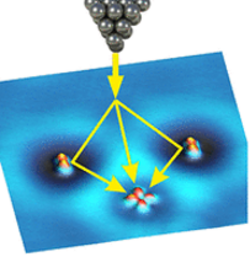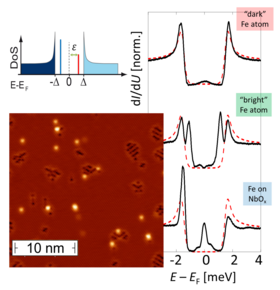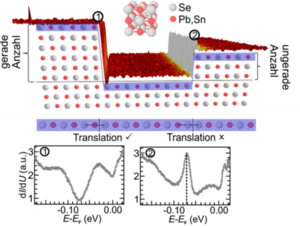Open Positions
We are always looking for motivated PhD students. Candidates will have the opportunity to work on their own project, allowing them to gain experience in both scientific as well as technical aspects of scanning tunneling microscopy. Potential research topics involve STM/STS studies of topological systems and superconductors (contact: artem.odobesko@uni-wuerzburg.de), magnetic nanostructures (jing.qi@uni-wuerzburg.de) and transport at the nanoscale (markus.leisegang@uni-wuerzburg.de).
We are offering Bachelor and Master projects covering all topcis of our research in the framework of scanning tunneling micrsocopy and spectroscopy. The projects are always connected to and/or embedded in on-going activities and are supervised by one of our PhD students or PostDocs.
More information about Bachelor and Master projects can also be found on the corresponding black board in the physics institute.
Bachelor Projects
If you would like to do your Bachelor thesis in our group, please contact Prof. Bode, so we can arange a small project connected to the current research in our group.
Master Projects
Below you can find a selection of current master projects. If you are interested in working with us, please contact one of the persons mentioned.
Master's Thesis
Switching spin spirals by stoichiometry
Manganese atoms on the iridium (001) surface self-assemble into manganese-oxide chains in an oxygen atmosphere. These chains exhibit intriguing spin structures that heavily depend on the stoichiometry, i.e., the number and position of the oxygen atoms in the chains [1,2]. In this work, the magnetic properties of chains made from other 3d elements, such as iron, cobalt, or nickel, will be examined. Further, a potential switching of the magnetic state of these chains by adding or removing oxygen atoms will be investigated.
[1] M. Schmitt et al., Nat. Commun. 10, 2610 (2019)
[2] M. Schmitt et al., PRB 100, 054431 (2019)
Tasks
- Growth of transition metal-oxide chains with various stoichiometries
- Investigation of structural and magnetic properties by STM/STS
- Data analysis with WSxM, MATLAB, python, ...
Contact
- Prof. Matthias Bode; Raum F 161;
matthias.bode@uni-wuerzburg.de - Jing Qi; Raum F 164;
jing.qi@uni-wuerzburg.de

Master's Thesis
Charge transport across magnetic nanostructures on the atomic scale
Reversible switching processes of some molecules can be used to detect charge currents on various surfaces in STM experiments. Based on this principle, we deve- loped the MOlecular NAnoprobe technique (MONA), that allows us to probe charge transport on the length scale of only few nanometers [1]. In this work, the MONA technique will be used to investigate transport across magnetic nanostructures built atom-by-atom on a single insulating layer of Cu2N.
[1] M. Leisegang et al., Nano Lett. 18, 2165 (2018)
[2] J. Gobeil et al., Surface Science 679, 202 (2019)
Tasks
- Growth of Cu2N and deposition of detector molecules
- Controlled manipulation of single magnetic atoms with the STM tip
- MONA measurements of the nanostructures
- Data analysis with WSxM, MATLAB, python., ...
Contact
- Prof. Matthias Bode; Raum F 161;
matthias.bode@uni-wuerzburg.de - Markus Leisegang; Raum F 178;
markus.leisegang@uni-wuerzburg.de

Master's Thesis
Investigation of localized states in magnetic adatoms on Nb(110)
The interaction of magnetic atoms and a supercon- ductor results in a variety of intriguing physical effects. Among other, the spins of these atoms create a pair-breaking potential for the Cooper pairs in the supercon- ductor, which results in the so-called Yu-Shiba-Rusinov (YSR) states. Coupling of such atoms in clusters or chains leads to the hybridization of the YSR states, which can ultimately induce topological superconduc- tivity in the system. After successfully investigating single and coupled Fe atoms on the elemental super- conductor niobium in the past [1,2], we now want to extend our study to atoms and chains of rare earth metals.
[1] A. Odobesko et al., PRB 102, 174504 (2020)
[2] F. Friedrich et al., PRB 103, 235437 (2021)
Tasks
- Spectroscopic investigation of YSR states in various magnetic adatoms on Nb(110) by STS
- Atom-by-atom fabrication of atomic chains by atomic manipulation with the STM tip
- Search for topological phenomena in these chains
Contact
- Prof. Matthias Bode; Raum F 161;
matthias.bode@uni-wuerzburg.de - Artem Odobesko; Raum F 176a; artem.odobesko@uni-wuerzburg.de

Master's Thesis
Growth and characterization of topo- logical insulator thin films on Nb(110)
Majorana fermions are particles which are equal to their own antiparticles and exhibit interesting properties for future generations of quantum computers. In solid state physics, they are predicted to appear at the edge or on the surface of topological superconductors. However, such topological superconductors are until today unknown in nature, and thus the synthetization of suitable materials became a widely researched topic. A promising approach in the field is the combination of a topological insulator (TI) with a conventional super- conductor [1]. The goal of this work is to grow TI thin films on a bulk superconductor and to study the proper- ties of this structure by scanning tunneling microcopy and spectroscopy.
[1] L. Fu und C. L. Kane, PRL 100, 096407 (2008)
Tasks
- Characterization of the film growth of TIs on Nb(110)
- Investigation of the electronic properties of the obtained films by STM/STS
Contact
- Prof. Matthias Bode; Raum F 161;
matthias.bode@uni-wuerzburg.de - Artem Odobesko; Raum F 176a; artem.odobesko@uni-wuerzburg.de
Master's Thesis
Influence of magnetic and non-magnetic adatoms on the 1D edge states of Pb1-xSnxSe
3D topological insulators usually exhibit protected two-dimensional surface states [1]. Yet, we recently disco- vered additional, one-dimensional edge states along specific step edges of the the topological crystalline insulator Pb1-xSnxSe [2]. Within the proposed work, the influence of magnetic and non-magnetic atoms on these edge states with will be studied.
[1] T. Hsieh et al., Nat. Commun. 3, 982 (2012)
[2] P. Sessi et al., Science 354, 1269-1273 (2016)
Tasks
- In-situ deposition of various magnetic and non-magnetic elements
- Scanning tunneling spectroscopy of the 1D edge states on the Pb1-xSnxSe (001) surface
Contact
- Prof. Matthias Bode; Raum F 161;
matthias.bode@uni-wuerzburg.de - Artem Odobesko; Raum F 176a; artem.odobesko@uni-wuerzburg.de
- Florian Keller; Raum F 163; florian.keller@physik.uni-wuerzburg.de






